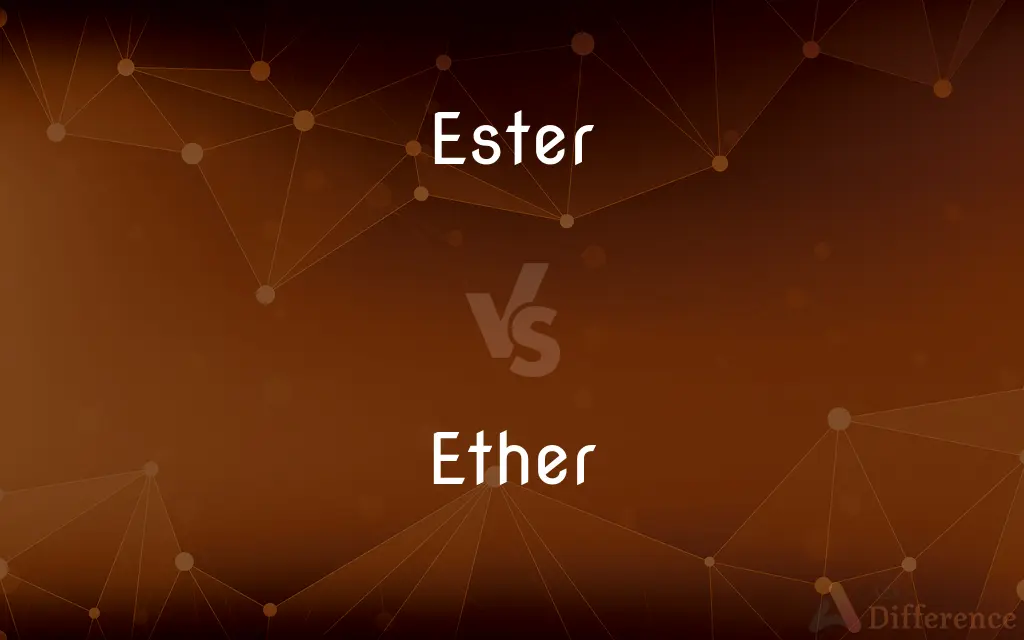Ester vs. Ether — What's the Difference?
By Urooj Arif & Fiza Rafique — Updated on March 16, 2024
Esters are chemical compounds derived from an acid where at least one -OH (hydroxyl) group is replaced by an -O- (alkoxy) group, while ethers are a class of organic compounds that contain an oxygen atom connected to two alkyl or aryl groups.

Difference Between Ester and Ether
Table of Contents
ADVERTISEMENT
Key Differences
Esters are known for their pleasant fragrances and are often used in food flavorings and perfumes, whereas ethers are known for their ether-like odor and are used as solvents in the pharmaceutical and chemical industries.
Esters are produced through a reaction known as esterification, where an acid reacts with an alcohol, while ethers are typically formed through the dehydration of alcohols.
In terms of stability, esters can be hydrolyzed back into alcohols and acids, especially in the presence of an acid or base catalyst, whereas ethers are generally more stable but can undergo cleavage in the presence of strong acids.
Ester molecules often have a polar nature due to the presence of the carbonyl group (C=O), which makes them somewhat soluble in water, whereas ethers are less polar and usually have limited water solubility.
Comparison Chart
Structure
Contains a carbonyl group adjacent to an ether linkage (-COOR)
Contains an oxygen atom connected to two alkyl or aryl groups (R-O-R)
ADVERTISEMENT
Odor
Often have pleasant, fruity smells
Typically have a distinct, ether-like odor
Solubility
Somewhat soluble in water due to the polar carbonyl group
Generally less soluble in water due to their less polar nature
Stability
Can be hydrolyzed back into alcohols and acids
More stable, but can undergo cleavage with strong acids
Common Uses
Used in fragrances, flavorings, and making polymers
Used as solvents in pharmaceuticals and as anesthetics
Compare with Definitions
Ester
The process of forming an ester by reacting an acid with an alcohol.
The formation of ethyl acetate from acetic acid and ethanol is an example of esterification.
Ether
An organic compound with an oxygen atom connected to two alkyl or aryl groups.
Diethyl ether is a common laboratory solvent.
Ester
A chemical compound derived from an acid where an -OH group is replaced by an -O- alkyl group.
Ethyl acetate (used in nail polish removers) has a sweet smell.
Ether
The breaking of the ether linkage, especially in the presence of strong acids.
The cleavage of dimethyl ether can produce methanol under specific conditions.
Ester
Esters often have distinctive fruity aromas.
Isoamyl acetate gives bananas their characteristic smell.
Ether
Ethers, due to their properties, have been used as anesthetics.
Diethyl ether was historically used for its anesthetic properties during surgeries.
Ester
A polymer made by linking ester groups in a chain.
Polyethylene terephthalate (PET) is used to make plastic bottles.
Ether
The characteristic -O- linkage in ethers.
In dimethyl ether, the oxygen is bonded to two methyl groups.
Ester
The chemical breakdown of esters in the presence of water, reverting them to alcohols and acids.
Saponification of esters leads to the formation of soap and alcohol.
Ether
Ethers are commonly used as solvents due to their ability to dissolve various substances.
Tetrahydrofuran (THF) is used as a solvent in organic synthesis.
Ester
An ester is a chemical compound derived from an acid (organic or inorganic) in which at least one –OH hydroxyl group is replaced by an –O– alkyl (alkoxy) group, as in the substitution reaction of a carboxylic acid and an alcohol. Glycerides are fatty acid esters of glycerol; they are important in biology, being one of the main classes of lipids and comprising the bulk of animal fats and vegetable oils.
Ether
Ethers are a class of organic compounds that contain an ether group—an oxygen atom connected to two alkyl or aryl groups. They have the general formula R–O–R′, where R and R′ represent the alkyl or aryl groups.
Ester
Any of a class of compounds derived from an oxyacid, usually resulting from the reaction of an oxyacid and an alcohol with the elimination of water.
Ether
Any of a class of organic compounds in which two hydrocarbon groups are linked by an oxygen atom.
Ester
(organic compound) A compound most often formed by the condensation of an alcohol and an acid, with elimination of water, which contains the functional group carbon-oxygen double bond (i.e., carbonyl) joined via carbon to another oxygen atom.
Ether
A volatile, highly flammable liquid, C4H10O, derived from distilling ethyl alcohol with sulfuric acid, used as a reagent and solvent, and formerly used as an anesthetic. Also called diethyl ether, ethyl ether.
Ester
An ethereal salt, or compound ether, consisting of an organic radical united with the residue of any oxygen acid, organic or inorganic; thus the natural fats are esters of glycerin and the fatty acids, oleic, etc.
Ether
The regions of space beyond the earth's atmosphere; the heavens.
Ester
Formed by reaction between an acid and an alcohol with elimination of water
Ether
The element believed in ancient and medieval civilizations to fill all space above the sphere of the moon and to compose the stars and planets.
Ether
(Physics) An all-pervading, infinitely elastic, massless medium formerly postulated as the medium of propagation of electromagnetic waves.
Ether
The substance formerly supposed to fill the upper regions of the atmosphere above the clouds, in particular as a medium breathed by deities.
Ether
(by extension) The medium breathed by human beings; the air.
Ether
(by extension) The sky, the heavens; the void, nothingness.
Ether
Often as aether and more fully as luminiferous aether: a substance once thought to fill all unoccupied space that allowed electromagnetic waves to pass through it and interact with matter, without exerting any resistance to matter or energy; its existence was disproved by the 1887 Michelson–Morley experiment and the theory of relativity propounded by Albert Einstein (1879–1955).
Ether
The atmosphere or space as a medium for broadcasting radio and television signals; also, a notional space through which Internet and other digital communications take place; cyberspace.
Ether
A particular quality created by or surrounding an object, person, or place; an atmosphere, an aura.
Ether
Diethyl ether (C4H10O), an organic compound with a sweet odour used in the past as an anaesthetic.
Ether
Any of a class of organic compounds containing an oxygen atom bonded to two hydrocarbon groups.
Ether
(uncountable) Starting fluid.
Ether
To viciously humiliate or insult.
The battle rapper ethered his opponent and caused him to slink away in shame.
Ether
A medium of great elasticity and extreme tenuity, once supposed to pervade all space, the interior of solid bodies not excepted, and to be the medium of transmission of light and heat; hence often called luminiferous ether. It is no longer believed that such a medium is required for the transmission of electromagnetic waves; the modern use of the term is mostly a figurative term for empty space, or for literary effect, and not intended to imply the actual existence of a physical medium. However. modern cosmological theories based on quantum field theory do not rule out the possibility that the inherent energy of the vacuum is greater than zero, in which case the concept of an ether pervading the vacuum may have more than metaphoric meaning.
Ether
Supposed matter above the air; the air itself.
Ether
A light, volatile, mobile, inflammable liquid, (C2H5)2O, of a characteristic aromatic odor, obtained by the distillation of alcohol with sulphuric acid, and hence called also sulphuric ether. It is a powerful solvent of fats, resins, and pyroxylin, but finds its chief use as an anæsthetic. Commonly called ethyl ether to distinguish it from other ethers, and also ethyl oxide.
Ether
A colorless volatile highly inflammable liquid formerly used as an inhalation anesthetic
Ether
The fifth and highest element after air and earth and fire and water; was believed to be the substance composing all heavenly bodies
Ether
Any of a class of organic compounds that have two hydrocarbon groups linked by an oxygen atom
Ether
A medium that was once supposed to fill all space and to support the propagation of electromagnetic waves
Common Curiosities
How are esters typically formed?
Esters are formed through esterification, a reaction between an acid and an alcohol.
What distinguishes an ester from an ether in terms of chemical structure?
Esters contain a carbonyl group adjacent to an ether linkage (-COOR), whereas ethers consist of an oxygen atom bonded to two alkyl or aryl groups (R-O-R).
Why are ethers less soluble in water than esters?
Ethers are less polar than esters, making them less compatible with water and therefore less soluble.
Can esters be broken down? If so, how?
Yes, esters can be hydrolyzed back into alcohols and acids, especially in the presence of an acid or base catalyst.
Can ethers undergo chemical reactions?
Yes, while ethers are generally stable, they can undergo reactions such as cleavage in the presence of strong acids.
What are some common uses of ethers?
Ethers are widely used as solvents in laboratories and industries, and some ethers have been used as anesthetics.
How do the boiling points of esters and ethers compare?
The boiling points of esters and ethers can vary widely depending on their molecular structures, but esters generally have higher boiling points due to their polar nature.
Are ethers flammable?
Many ethers are highly flammable and must be handled with care, especially in laboratory and industrial settings.
Why do esters often have pleasant smells?
Esters can have complex structures that interact with olfactory receptors in diverse ways, often producing pleasant, fruity aromas.
What is the significance of the ether linkage in organic chemistry?
The ether linkage is a functional group that imparts unique chemical properties to ethers, such as their ability to act as solvents.
What is a polyester, and how is it related to esters?
Polyester is a type of polymer made by linking ester groups in a chain, commonly used in fabrics and plastics.
What role do esters play in the food industry?
Esters are used to synthesize artificial flavors and fragrances, contributing to the aroma and taste of various food products.
How does the presence of a carbonyl group affect an ester's properties?
The carbonyl group in esters contributes to their polarity, reactivity, and the ability to participate in hydrogen bonding, influencing their solubility and boiling points.
Can esters be found in nature?
Yes, many esters are naturally occurring compounds, often contributing to the fragrances and flavors of fruits and flowers.
What is the historical significance of ether in medicine?
Ether was one of the first anesthetics used in surgery, revolutionizing medical procedures by allowing pain-free operations.
Share Your Discovery

Previous Comparison
Mesa vs. Butte
Next Comparison
Papillary vs. MacularAuthor Spotlight
Written by
Urooj ArifUrooj is a skilled content writer at Ask Difference, known for her exceptional ability to simplify complex topics into engaging and informative content. With a passion for research and a flair for clear, concise writing, she consistently delivers articles that resonate with our diverse audience.
Co-written by
Fiza RafiqueFiza Rafique is a skilled content writer at AskDifference.com, where she meticulously refines and enhances written pieces. Drawing from her vast editorial expertise, Fiza ensures clarity, accuracy, and precision in every article. Passionate about language, she continually seeks to elevate the quality of content for readers worldwide.














































